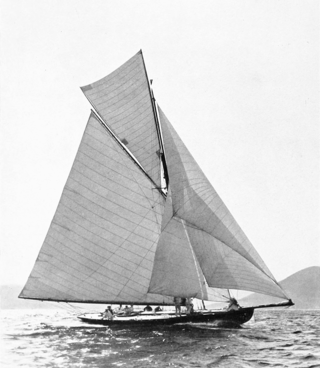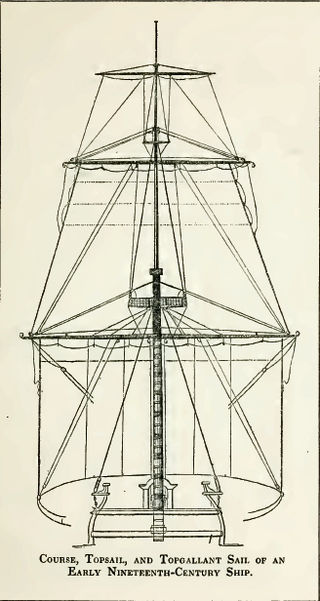Related Research Articles

A sloop is a sailboat with a single mast typically having only one headsail in front of the mast and one mainsail aft of (behind) the mast. Such an arrangement is called a fore-and-aft rig, and can be rigged as a Bermuda rig with triangular sails fore and aft, or as a gaff-rig with triangular foresail(s) and a gaff rigged mainsail.

A sailboat or sailing boat is a boat propelled partly or entirely by sails and is smaller than a sailing ship. Distinctions in what constitutes a sailing boat and ship vary by region and maritime culture.

A sailing vessel's rig is its arrangement of masts, sails and rigging. Examples include a schooner rig, cutter rig, junk rig, etc. A rig may be broadly categorized as "fore-and-aft", "square", or a combination of both. Within the fore-and-aft category there is a variety of triangular and quadrilateral sail shapes. Spars or battens may be used to help shape a given kind of sail. Each rig may be described with a sail plan—formally, a drawing of a vessel, viewed from the side.

A catboat is a sailboat with a single sail on a single mast set well forward in the bow of a very beamy and (usually) shallow draft hull. Typically they are gaff rigged, though Bermuda rig is also used. Most are fitted with a centreboard, although some have a keel. The hull can be 3.7 to 12.2 metres long with a beam half as wide as the hull length at the waterline. The type is mainly found on that part of the Eastern seaboard of the USA from New Jersey to Massachusetts.

A topsail ("tops'l") is a sail set above another sail; on square-rigged vessels further sails may be set above topsails.

A Bermuda rig, Bermudian rig, or Marconi rig is a configuration of mast and rigging for a type of sailboat and is the typical configuration for most modern sailboats. This configuration was developed in Bermuda in the 1600s; the term Marconi, a reference to the inventor of the radio, Guglielmo Marconi, became associated with this configuration in the early 1900s because the wires that stabilize the mast of a Bermuda rig reminded observers of the wires on early radio masts.

A Thames sailing barge is a type of commercial sailing boat once common on the River Thames in London. The flat-bottomed barges with a shallow draught and leeboards, were perfectly adapted to the Thames Estuary, with its shallow waters and narrow tributary rivers. The larger barges were seaworthy vessels, and were the largest sailing vessel to be handled by just two men. The average size was about 120 tons and they carried 4,200 square feet (390 m2) of canvas sail in six working sails. The mainsail was loose-footed and set up with a sprit, and was brailed to the mast when not needed. It is sheeted to a horse, as is the foresail; they require no attention when tacking. The foresail is often held back by the mate to help the vessel come about more swiftly.

PNS Rah Naward is a sail training ship of the Pakistan Navy. She was commissioned in 2001 as Prince William for the Tall Ships Youth Trust and sold in 2010 to the Pakistan Navy and renamed Rah Naward.

The Friendship sloop, also known as a Muscongus Bay sloop or lobster sloop, is a gaff-rigged working boat design that originated in Friendship, Maine around 1880 and has survived as a traditional-style sailboat.

The J-class yacht Velsheda was designed by Charles Ernest Nicholson and built in 1933 by Camper and Nicholsons at Gosport, Hampshire. She was built for businessman William Lawrence Stephenson and between 1933 and 1936, she won many races and competed with other yachts of her era such as Britannia, Endeavour and Shamrock V.

The Bermuda Fitted Dinghy is a type of racing-dedicated sail boat used for competitions between the yacht clubs of Bermuda. Although the class has only existed for about 130 years, the boats are a continuance of a tradition of boat and ship design in Bermuda that stretches back to the earliest decades of the 17th century.
Alexandria was a cargo-carrying three-masted schooner built in 1929. Originally named Yngve, she was built at Björkenäs, Sweden, and fitted with a 58 H.P. auxiliary oil engine.

Charles Ernest Nicholson was a British yacht designer.

Shamrock V was the first British yacht to be built to the new J-Class rule. She was commissioned by Sir Thomas Lipton for his fifth America's Cup challenge. Although refitted several times, Shamrock is the only original J-class never to have fallen into dereliction.
Enterprise was a 1930 yacht of the J Class and successful defender of the 1930 America's Cup for the New York Yacht Club. It was ordered by a syndicate headed by Vice-Commodore Winthrop Aldrich, designed by Starling Burgess, and built by Herreshoff Manufacturing Company.

The Falmouth Working Boat is a type of small traditional sailing craft that evolved for fishing in the waters of Falmouth, Cornwall.
The following outline is provided as an overview of and topical guide to sailing:

The Sea Pearl 21 is an American trailerable sailboat or sailing dinghy, that was designed by Ron Johnson as a daysailer and first built in 1982.
Camper and Nicholson was a yacht design and manufacturing company based in Gosport, England, for over two hundred years, constructing many significant vessels, such as Gipsy Moth IV and Prince Philip's yacht Bloodhound. Its customers included Thomas Sopwith, William Kissam Vanderbilt II and George Spencer-Churchill, 6th Duke of Marlborough. Its yachts competed in The America's Cup, The Fastnet Race, the Olympics, the Ocean Race and many other yacht races.

A sail plan is a drawing of a sailing craft, viewed from the side, depicting its sails, the spars that carry them and some of the rigging that supports the rig. By extension, "sail plan" describes the arrangement of sails on a craft. A sailing craft may be waterborne, an iceboat, or a sail-powered land vehicle.
References
- ↑ John Leather (2001). The Gaff Rig Handbook: History, Design, Techniques, Developments. p. 58. ISBN 9780937822678.
{{cite book}}:|work=ignored (help) - ↑ Ian Dear (2001). Camper & Nicholsons: Two Centuries of Yacht Building. Quiller Press. p. 57. ISBN 9781899163649.
- 1 2 "Allom won't challenge" (PDF). The New York Times. 1916-03-15.